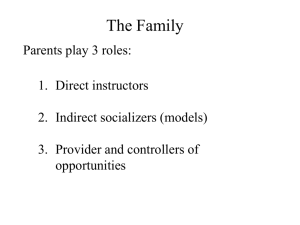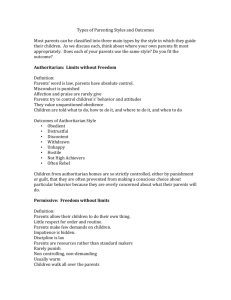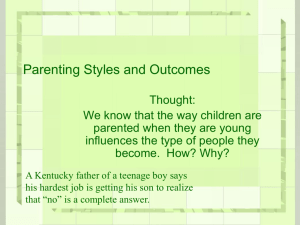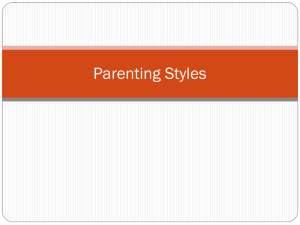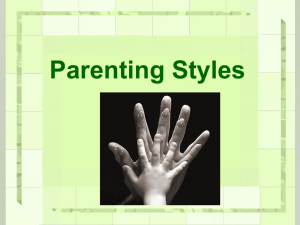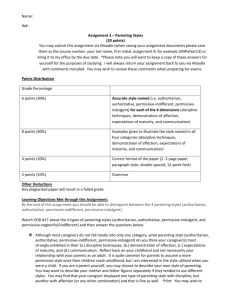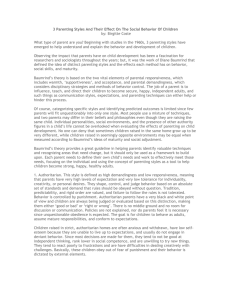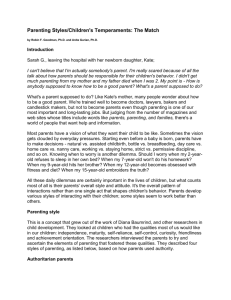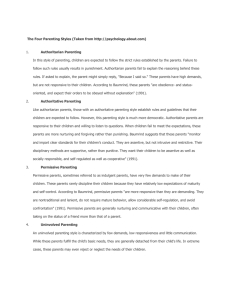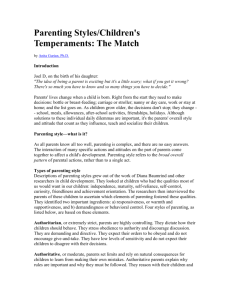Parenting Styles PPt
advertisement
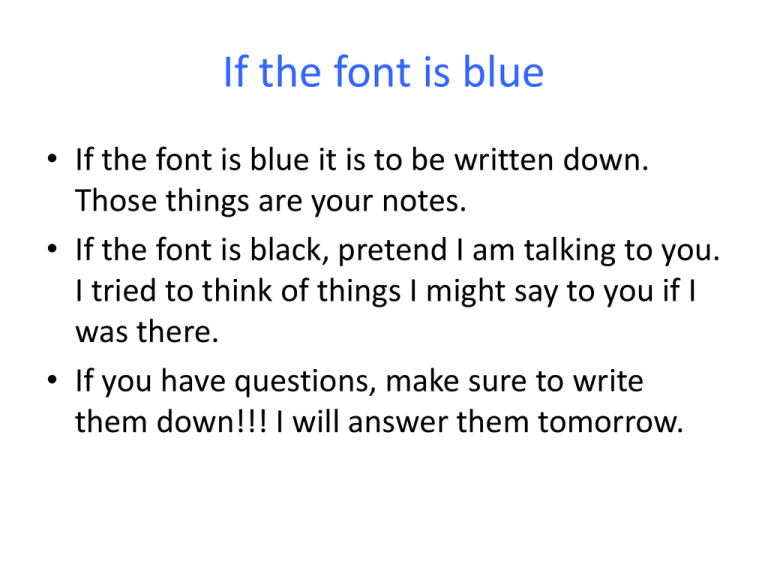
If the font is blue • If the font is blue it is to be written down. Those things are your notes. • If the font is black, pretend I am talking to you. I tried to think of things I might say to you if I was there. • If you have questions, make sure to write them down!!! I will answer them tomorrow. Parenting Styles What style will you Be? Will you always use the same style? If you want to raise a responsible child… • Most parents don’t research parenting styles • You may have thought “I will not do as my parents did.” • Studying and thinking about how the different styles affect behavior may help you to decide how to act and react to children. • There are 4 basic styles: Authoritarian Authoritative Democratic Permissive Four Parenting Styles • • • • Authoritarian Authoritative Assertive-Democratic Permissive Authoritarian • strict parents are highly controlling • dictate how their children should behave • stress obedience to authority and discourage discussion • expect their orders to be obeyed and do not encourage give-and-take • low levels of sensitivity and do not expect their children to disagree with their decisions. Authoritarian • Examples “You come back here right this minute and give that ball back to Michael immediately.” “You can’t go to the mall without me so don’t ask again. Authoritative • set limits and rely on natural consequences for children to learn from making their own mistakes • explain why rules are important and why they must be followed • reason with their children and consider the children's point of view even though they might not agree • are firm, with kindness, warmth and love • set high standards and encourage children to be independent Authoritative • “The ball belongs to Michael. I know you want to play with it, but why don't you talk it over with him and try and work out a system to take turns?” • “I am concerned about you going to the mall by with just your friends. I’ll come along. We’ll plan to meet every 45 minutes so we can check on each other. That way, if there is a problem I can be right there to help. This is the only way I am willing to let you go.” Assertive-Democratic • Children have some input in rules • Independence is fostered by giving the child a certain amount of independence and freedom of choice within rules • When rules are broken both the child and the parent problem solve together to find acceptable punishments Assertive-Democratic • “The ball belongs to Michael. Can you ask Michael if he is willing to take turns? If he says no, then you need to think of another activity to do. I can help you think of new things to do if you like” • “I am concerned about you going to the mall with just your friends. Let’s think about a different plan. How about I come to the mall and sit at the food court and you can check in every ½ hour or so? If not that, may be someone’s older brother or sister can go with you guys.” Permissive • Indulgent parents who exert little control • Do not set limits • Allow children to set their own rules, schedules, and activities • Do not make demands about behavior Permissive Parents • They do not interfere with the children disagreeing over the ball. They feel it is better to let them figure it out on their own. • Allow the child to go to the mall Do I have to be the same parenting type all the time? • NO! • The age of the child, the type of activity or behavior should dictate which type of parenting style you use. • Because Authoritarian parents don’t allow give and take, the authoritarian parenting style should only be used when a child should never have a choice, i.e. what ever they want to do would put them in danger. Examples Child age 4 colors on walls: Authoritarian: yells at child takes away markers and sends to bed Authoritative: takes markers, talks about where should have drawn and why. Has child help clean the wall. Decides child will not have markers for a week. Assertive Democratic: takes markers, has child help clean wall. Discusses where a child can draw. Discusses what consequence should occur. Examples • Permissive Doesn’t respond to the drawing. Ask yourself: • • • • • • Which parenting style works for you? Which one do you think will help guide a child the next time they think about acting in the same manner? Is the child in danger? Have they placed anyone else in danger? Have they caused some one pain or destroyed or ruined property? Do they understand the consequences of their actions? Am I making up a rule, just to make up a rule or to just suit my purposes. Is there value in the rule for the child? Remember • Everyone has differing opinions • Not everyone will act/react in the same manner • What behaviors are so important to you that you want to be firm and nonnegotiable? • Which behaviors can you give a child some freedom? Examples of varied parenting For the 4-6 year old • Authoritarian: you may not play in the street • Authoritative: I know you don’t like eating broccoli, but I have also made green beans. You must eat one or the other. Examples of varied parenting • Assertive Democratic: I have put out 3 outfits that are okay for you to wear today. Which one would you like to wear? • Permissive You may play with any of your toys right now Reasoning • All of the above examples are reasonable uses of parenting styles. They answer the questions raised earlier about safety, control, respect, and autonomy. • Now complete the worksheet Parenting Styles Practice You may work with your table. It will be collected for a grade. Think about it • Now complete Practice Parenting Scenarios • Work with a partner, be prepared to discuss your answers tomorrow. Be Positive! • When you want children to listen, tell them what you want, NOT what you don’t want. • Example: If the child is getting water all over the sink when washing their hands say: “Hold your hands lower in the sink, that way the water stays in the sink” instead of “Stop splashing water everywhere!” Practice make perfect • Being positive and setting up an environment where a child can meet success is not an easy task. • Imagine this: it has snowed last night and Johnny aged 5, is excited about playing in the snow. You bundle him all up go outside and within 5 minutes he has to go to the bathroom. He rushes in the house, tracks snow everywhere, can’t get out of the snow suit in time and wets his pants! UGH! • What if… What if… • Before you let Johnny outside, you make sure he has gone to the bathroom • You have placed baskets near the door for boots, scarves, gloves, etc. so that snow, water, mud are not tracked through the house You have created a positive environment that the child can be successful at maintaining. You have thought about what the child will want to do and did some trouble shooting so that both of you are happy and not upset. What can you do ahead of time • You are going on vacation to the beach. Nina, age 3 gets bored in the car easily. What can you do ahead of time to try to make the trip easier for you and Nina? With your table, brainstorm some ideas. What can you do ahead of time • Your 7 year old has a play date at your house. He will want to play with his friend but you also want your 5 year old to be able to play as well. How can you set up the scene so the both 7 and 5 year old will be happy? With your table, brainstorm some ideas. Now add positive words • When your children are playing, encourage them by telling them what they are doing well and when they aren’t doing something you want them to do, THINK, how can it be worded positively? Time to Practice • Complete the worksheet Being Positive • Make sure you state what you want them to do! • Turn in when complete.
